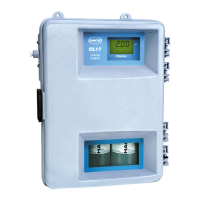Section 2
Page 35
54400_start.fm Supplying Sample
2.5 Supplying Sample
Note: Make sure the pressure plate
is securely attached to avoid
backflow of the sample into
the reagents.
Start sample flow through the instrument by opening the supply valve (item 19
in Figure 6 on page 19). Allow the pressure in the tubing to stabilize and
check for leaks.
Until the surface of the sample cell becomes completely wetted, bubbles may
cling to the sample cell and cause erratic readings. This condition is
temporary. Its duration depends on the sample properties.
2.6 Supplying Power
The power switch is located inside the enclosure door in the recessed area to
the left of the colorimeter block. Set the POWER (–/O) switch to ON (–) and
allow the analyzer to operate for approximately two hours to ensure the
system is completely wetted with reagents and sample.
2.7 Instrument Menu Structure
The major menus in the CL17 Analyzer consist of ALARMS, RECRDR, MAINT,
and
SETUP. Press the UP or DOWN ARROW keys to access the menus. The
sections below give information on the functions of each of the menus and the
submenus within them.
2.7.1 Setup Menu
Day-to-day analyzer functions are accessed from the SETUP menu. To enter
the
SETUP menu, press the MENU key, then use the UP ARROW key to scroll to
the
SETUP option. Press ENTER.
Scroll through the
SETUP menu options using the UP and DOWN ARROW keys.
Press
ENTER to select the displayed menu option. Arrow icons are displayed if
the display is editable. Press the
EXIT key to back out of a menu and return to
SETUP. The menu information below is presented in the order it appears in the
SETUP menu.
•SIGAVG—The SIGAVG feature is used to average readings and prevent
erratic recorder output signals. Press
ENTER, use the UP and DOWN
ARROW keys to select 1, 2, 3, or 4, then press ENTER to accept the
displayed selection. Depending on the value selected, the last 1, 2, or 3
measurements are averages and the reported concentration is the
averaged values. Option 4 is a special filter, which only reports the
maximum value between the current reading and the last. This feature
reduces negative spikes due to bubbles and other abnormalities in the
sample. The factory default is 1. Press
EXIT to return to the SETUP menu.
Note: A properly maintained
instrument in good working
condition will read within the
accuracy specifications presented in
Specifications on page 6. The
calibration function should never be
used to force an analyzer that is not
working correctly to display a correct
reading. Calibrations are intended
for very small adjustments only.
• CAL ZERO—this feature is used to offset the instrument zero using a
prepared zero standard. If the offset is too large, a marginal zero (MARG
Z) warning will occur. See Calibration on page 40.
• CAL STD—This feature is used to adjust the analyzer slope using a
prepared standard. If the adjustment is too large, the analyzer will not
accept it and a marginal gain (MARG G) warning will occur. The new
standard will not be accepted and it will have to be checked again using
another method to establish a more exact reading. See Calibration on
page 40.

